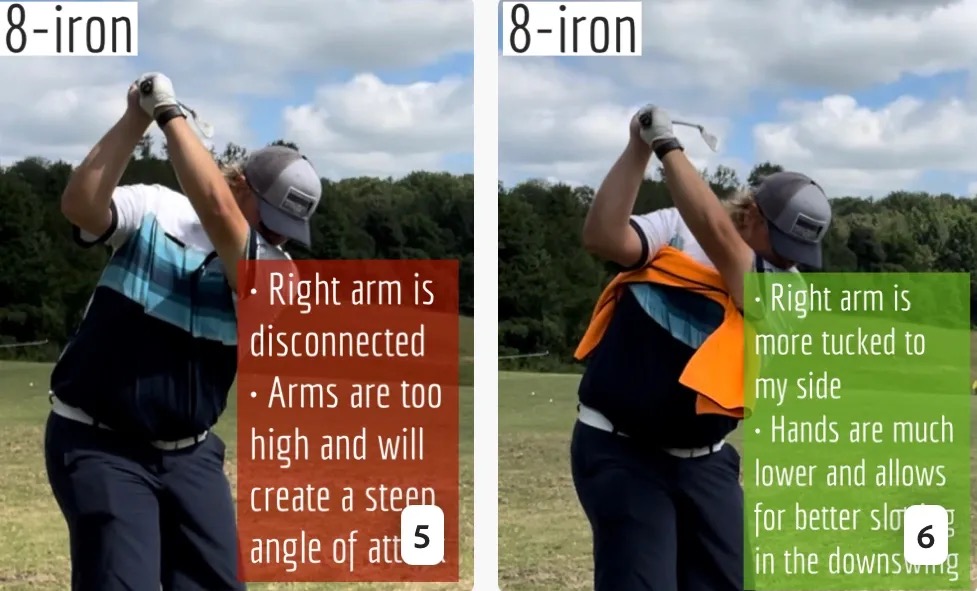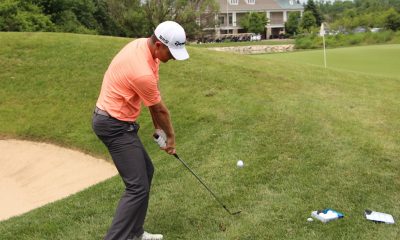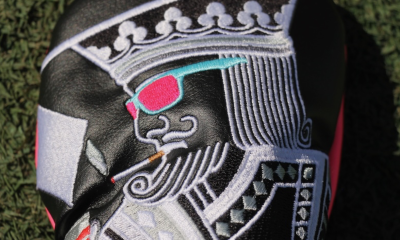Instruction
The Wedge Guy: 5 indisputable rules of bunker play

Let’s try to cover the basics of sand play – the “geometry and physics” at work in the bunkers – and see if we can make all of this more clear.
First of all, I think bunkers are among the toughest of places to find your ball. We see the tour players hit these spectacular bunker shots every week, but realize that they are playing courses where the bunkers are maintained to PGA standards, so they are pretty much the same every hole and every week. This helps the players to produce the “product” the tour is trying to deliver – excitement. Of course, those guys also practice bunker play every day.
All of us, on the other hand, play courses where the bunkers are different from one another. This one is a little firmer, that one a little softer. So, let me see if I can shed a little light on the “whys and wherefores” of bunker play. I’ve always challenged the old adage, “bunker shots are easy; you don’t even have to hit the ball.” I challenge that because bunker shots are the ONLY ones where you don’t actually try to hit the ball, so that makes them lie outside your norm.
Let’s start with a look at the sand wedge; they all have a sole with a downward/backward angle built into it – we call that bounce. It’s sole (no pun intended) function is to provide a measure of “rejection” force or lift when the club makes contact with the sand. The more bounce that is built into the sole of the wedge, the more this rejection force will affect the shot. And when we open the face of the wedge, we increase the effective bounce so that this force is increased as well.
The most basic thing you have to assess when you step into a bunker is the firmness of the sand. It stands to reason that the firmer the texture, the more it will reject the digging effect of the wedge. That “rejection quotient” also determines the most desirable swing path for the shot at hand. Firmer sand will reject the club more, so you can hit the shot with a slightly more descending clubhead path. Conversely, softer or fluffier sand will provide less rejection force, so you need to hit the shot with a shallower clubhead path so that you don’t dig a trench.
So, with these basic principles at work, it makes sense to remember these “Five Indisputable Rules of Bunker Play”:
- Firmer sand will provide more rejection force – open the club less and play the ball back a little to steepen the bottom of the clubhead path.
- Softer sand will provide less rejection force – open the club more and play the ball slighter further forward in your stance to create a flatter clubhead path through the impact zone.
- The ball will come out on a path roughly halfway between the alignment of your body and the direction the face is pointing – the more you open the face, the further left your body should be aligned.
- On downslope or upslope lies, try to set your body at right angles to the lie, so that your swing path can be as close to parallel with the ground as possible, so this geometry can still work. Remember that downhill slopes reduce the loft of the club and uphill slopes increase the loft.
- Most recreational golfers are going to hit better shots from the rough than the bunkers, so play away from them when possible (unless bunker play is your strength).
So, there you go – the five undisputable rules of bunker play.
As always, I invite all of you to send in your questions to be considered for a future article. It can be about anything related to golf equipment or playing the game – just send it in. I need your input to keep writing about things you want to know.
- LIKE131
- LEGIT13
- WOW3
- LOL5
- IDHT2
- FLOP2
- OB1
- SHANK5
Instruction
Clement: Stop ripping off your swing with this drill!

Not the dreaded headcover under the armpit drill! As if your body is defective and can’t function by itself! Have you seen how incredible the human machine is with all the incredible feats of agility all kinds of athletes are accomplishing? You think your body is so defective (the good Lord is laughing his head off at you) that it needs a headcover tucked under the armpit so you can swing like T-Rex?
- LIKE0
- LEGIT0
- WOW1
- LOL0
- IDHT0
- FLOP0
- OB0
- SHANK1
Instruction
How a towel can fix your golf swing

This is a classic drill that has been used for decades. However, the world of marketed training aids has grown so much during that time that this simple practice has been virtually forgotten. Because why teach people how to play golf using everyday items when you can create and sell a product that reinforces the same thing? Nevertheless, I am here to give you helpful advice without running to the nearest Edwin Watts or adding something to your Amazon cart.
For the “scoring clubs,” having a solid connection between the arms and body during the swing, especially through impact, is paramount to creating long-lasting consistency. And keeping that connection throughout the swing helps rotate the shoulders more to generate more power to help you hit it farther. So, how does this drill work, and what will your game benefit from it? Well, let’s get into it.
Setup
You can use this for basic chip shots up to complete swings. I use this with every club in my bag, up to a 9 or 8-iron. It’s natural to create incrementally more separation between the arms and body as you progress up the set. So doing this with a high iron or a wood is not recommended.
While you set up to hit a ball, simply tuck the towel underneath both armpits. The length of the towel will determine how tight it will be across your chest but don’t make it so loose that it gets in the way of your vision. After both sides are tucked, make some focused swings, keeping both arms firmly connected to the body during the backswing and follow through. (Note: It’s normal to lose connection on your lead arm during your finishing pose.) When you’re ready, put a ball in the way of those swings and get to work.

Get a Better Shoulder Turn
Many of us struggle to have proper shoulder rotation in our golf swing, especially during long layoffs. Making a swing that is all arms and no shoulders is a surefire way to have less control with wedges and less distance with full swings. Notice how I can get in a similar-looking position in both 60° wedge photos. However, one is weak and uncontrollable, while the other is strong and connected. One allows me to use my larger muscles to create my swing, and one doesn’t. The follow-through is another critical point where having a good connection, as well as solid shoulder rotation, is a must. This drill is great for those who tend to have a “chicken wing” form in their lead arm, which happens when it becomes separated from the body through impact.
In full swings, getting your shoulders to rotate in your golf swing is a great way to reinforce proper weight distribution. If your swing is all arms, it’s much harder to get your weight to naturally shift to the inside part of your trail foot in the backswing. Sure, you could make the mistake of “sliding” to get weight on your back foot, but that doesn’t fix the issue. You must turn into your trial leg to generate power. Additionally, look at the difference in separation between my hands and my head in the 8-iron examples. The green picture has more separation and has my hands lower. This will help me lessen my angle of attack and make it easier to hit the inside part of the golf ball, rather than the over-the-top move that the other picture produces.


Stay Better Connected in the Backswing
When you don’t keep everything in your upper body working as one, getting to a good spot at the top of your swing is very hard to do. It would take impeccable timing along with great hand-eye coordination to hit quality shots with any sort of regularity if the arms are working separately from the body.
Notice in the red pictures of both my 60-degree wedge and 8-iron how high my hands are and the fact you can clearly see my shoulder through the gap in my arms. That has happened because the right arm, just above my elbow, has become totally disconnected from my body. That separation causes me to lift my hands as well as lose some of the extension in my left arm. This has been corrected in the green pictures by using this drill to reinforce that connection. It will also make you focus on keeping the lead arm close to your body as well. Because the moment either one loses that relationship, the towel falls.


Conclusion
I have been diligent this year in finding a few drills that target some of the issues that plague my golf game; either by simply forgetting fundamental things or by coming to terms with the faults that have bitten me my whole career. I have found that having a few drills to fall back on to reinforce certain feelings helps me find my game a little easier, and the “towel drill” is most definitely one of them.
- LIKE11
- LEGIT1
- WOW2
- LOL0
- IDHT0
- FLOP2
- OB0
- SHANK8
Instruction
Clement: Why your practice swing never sucks

You hear that one all the time; I wish I could put my practice swing on the ball! We explain the huge importance of what to focus on to allow the ball to be perfectly in the way of your practice swing. Enjoy!
- LIKE0
- LEGIT0
- WOW0
- LOL0
- IDHT0
- FLOP0
- OB0
- SHANK1
-

 Opinion & Analysis3 weeks ago
Opinion & Analysis3 weeks agoThe Wedge Guy: Golf mastery begins with your wedge game
-

 19th Hole1 week ago
19th Hole1 week agoTour pro calls Anthony Kim a ‘f*****g idiot’ following Instagram comeback post
-

 19th Hole1 week ago
19th Hole1 week agoThis Rory McIlroy post-round ‘The Match’ moment is going viral…but all is likely not what it seems
-

 19th Hole1 week ago
19th Hole1 week agoAnthony Kim’s speculated LIV Golf sign-on fee may surprise you
-

 19th Hole3 weeks ago
19th Hole3 weeks ago6-time Euro Tour champ says Patrick Cantlay ‘should be nailed with a huge fine’ over Genesis incident
-

 Whats in the Bag3 days ago
Whats in the Bag3 days agoScottie Scheffler WITB 2024 (March)
-

 Tour Photo Galleries3 days ago
Tour Photo Galleries3 days agoPhotos from the 2024 Arnold Palmer Invitational
-

 Whats in the Bag1 week ago
Whats in the Bag1 week agoAnthony Kim WITB 2024 (February)














Dennis
Jun 8, 2023 at 1:26 pm
What about different bounce for firmer sand?
Livininparadise
Jun 8, 2023 at 9:54 am
Great tips, thanks.
I agree that the inconsistencies that I play on a normal basis, along with very few courses having practice bunkers make the shot much more difficult than it should